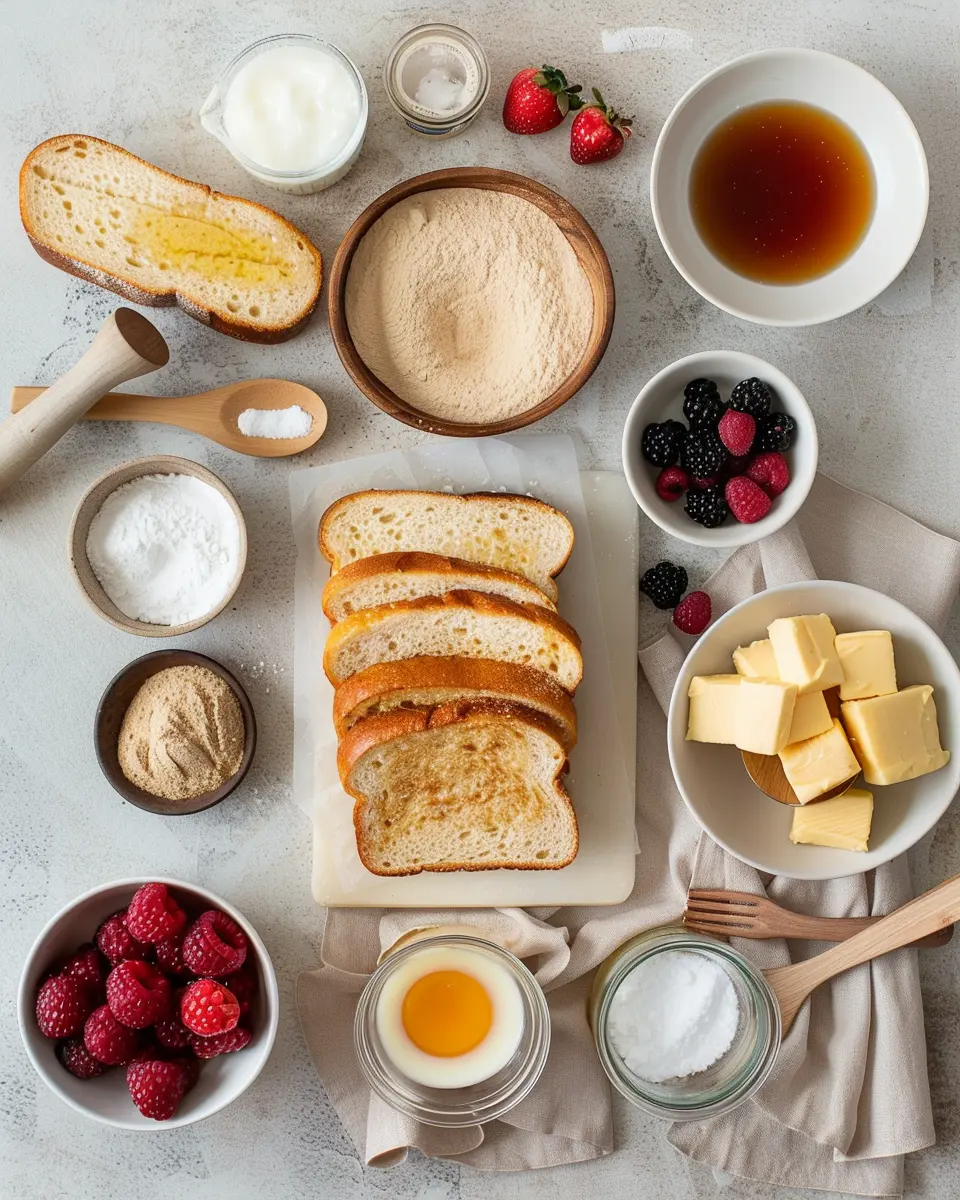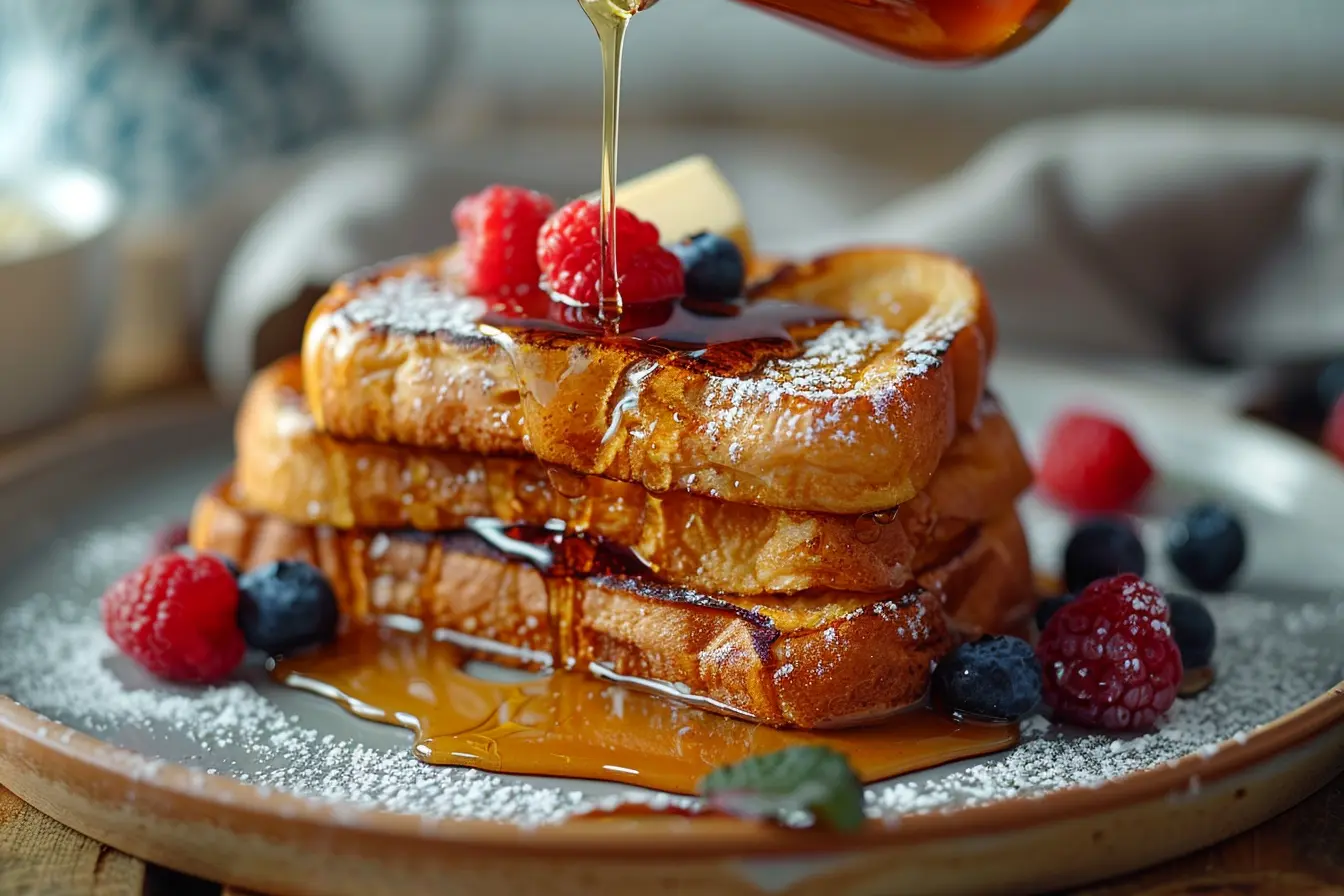If you’re craving a breakfast classic that’s fast, foolproof, and endlessly customizable, this is the best French toast recipe for you. With a simple egg‑and‑milk custard, a hint of vanilla and cinnamon, and 6 slices of sturdy bread, you’ll turn everyday ingredients into crisp‑edged, custardy‑in‑the‑middle perfection—ready in about 15 minutes. Whether you prefer brioche, challah, country white, whole wheat, cinnamon‑raisin, Italian, or French bread, this method delivers consistent results every time. Serve hot with butter and maple syrup, dust with powdered sugar, and add fresh berries for a café‑style plate at home.
Looking for more breakfast inspiration? Try Cinnamon Belgian Waffles, Easy Swedish Pancakes, or Breakfast Crêpes next—this simple technique slots right into any weekend brunch menu and scales easily for crowds.
Why This French Toast Recipe Works
- Custard ratio that just works: The balance of eggs to milk gives a silky custard that penetrates the bread without turning it soggy. A small pinch of salt sharpens flavor, while vanilla and cinnamon add warmth without overwhelming the bread.
- High, even heat: A hot skillet or griddle encourages Maillard browning for crisp edges while the center stays soft. Butter adds flavor; a touch of neutral oil raises the smoke point for batch cooking.
- Flexible bread choices: From brioche to whole wheat, the method adapts to what you have—stale bread actually helps by soaking up custard without falling apart.
- Minimal ingredients, maximum flavor: Five pantry staples—milk, eggs, vanilla, cinnamon, salt—create that diner‑style aroma and flavor in minutes.
- Scalable breakfast: The base recipe doubles or triples easily; slices hold well in a low oven without getting steamy or limp.
Ingredient Notes

Base recipe yields 6 slices (3–4 servings)
- Milk (2/3 cup): Any kind—whole, 2%, skim, or unsweetened plant‑based. Whole milk gives the richest texture; barista‑style oat or soy also works well. For extra richness, replace 2–3 tablespoons of milk with heavy cream.
- Eggs (2 large): Provide body and custard set. Very fresh eggs whisk more evenly; however, standard large eggs are perfect here.
- Vanilla extract (1 teaspoon, optional): Classic bakery aroma; swap with almond extract for a nutty twist.
- Ground cinnamon (1/4 teaspoon, optional): Adds warmth. Try pumpkin pie spice or a pinch of nutmeg instead.
- Salt (pinch): Essential for balance—don’t skip it.
- Bread (6 thick slices): Brioche or challah for ultra‑custardy slices; country white, Italian, or French bread for crisper edges; whole wheat for a heartier result. Slightly stale (day‑old) bread is ideal.
- Unsalted butter (1 tablespoon+): For frying; swirl in a teaspoon of neutral oil to reduce scorching during longer batches.
- To finish: Warm maple syrup, powdered sugar, berries, banana slices, Greek yogurt, or a dollop of whipped cream.
- Bread (6 thick slices): For why slightly stale bread absorbs custard better, see King Arthur Baking on stale bread.
- Eggs (2 large): Safe handling and storage guidance from USDA FSIS.
- Milk (⅔ cup): Storage times and temps from FoodSafety.gov cold storage charts.
- Vanilla & cinnamon: For an in‑depth technique explainer, see Serious Eats: How to Make French Toast.
Step‑by‑Step: How to Make the Best French Toast
- Make the custard
In a wide, shallow bowl, whisk together 2/3 cup milk, 2 large eggs, 1 teaspoon vanilla, 1/4 teaspoon cinnamon, and a pinch of salt until smooth—no streaks of egg white. - Preheat your cooking surface
Set a nonstick skillet or griddle over medium to medium‑high heat. Add 1 teaspoon butter; when it melts and foams, you’re ready to cook. If butter browns too quickly, reduce heat slightly. - Soak the bread (briefly)
Dip each slice 5–10 seconds per side for softer breads and up to 15 seconds for sturdier or day‑old bread. Let excess drip off—this prevents sogginess and helps crisping. - Cook to golden perfection
Lay slices on the hot surface. Cook 3–4 minutes per side until deep golden with crisp edges and a springy center. Add a small pat of butter between batches as needed. - Serve immediately
Plate with butter and warm maple syrup. Optional toppings: powdered sugar, berries, banana, yogurt, or compote.
Food‑safety reminders for American kitchens:
- Keep raw egg custard chilled between batches if you pause.
- Refrigerate leftovers within 2 hours (1 hour if above 90°F/32°C).
- Reheat leftovers until the center is steaming hot.
Pro Tips, Variations, and Flavor Ideas
Pro tips
- Use drier bread: Yesterday’s loaf drinks custard without disintegrating. For fresh bread, lightly toast it or leave slices out for 15–20 minutes.
- Butter + oil combo: A teaspoon of neutral oil with butter raises the smoke point and keeps batch two tasting like batch one.
- Keep warm for a crowd: Hold cooked slices on a wire rack set over a baking sheet in a 200–220°F (95–105°C) oven for up to 20–30 minutes—airflow preserves crisp edges.
- Even browning: Don’t overcrowd the pan. Space around slices = better crust and easier flipping.
- Sweetness control: Sweetness mainly comes from toppings; keep the custard itself lightly sweet or unsweetened for flexibility.
Flavor variations
- Classic cinnamon‑vanilla: As written.
- Citrus zest: Add 1/2–1 teaspoon orange or lemon zest to the custard for brightness.
- Brown‑sugar brûlée: Sprinkle a pinch of brown sugar on the first cooked side before flipping; it caramelizes into a delicate crackle.
- Chai‑spiced: Use 1/2 teaspoon chai spice instead of cinnamon.
- Savory twist: Skip vanilla/cinnamon; add black pepper and a pinch of thyme. Top with a fried egg and crispy bacon.
- Stuffed French toast: Spread cream cheese and jam or ricotta and honey between slices; soak briefly and cook slower on medium heat.
Dietary swaps
- Dairy‑free: Use unsweetened oat, soy, or almond milk; cook in neutral oil or dairy‑free butter.
- Gluten‑free: Choose thick‑sliced gluten‑free bread with good structure.
High‑protein tweak
- Add 1 extra egg and reduce milk by 2 tablespoons for a firmer, higher‑protein custard.
Serving The French Toast Suggestions

- Classic diner: Butter, warm maple syrup, and powdered sugar.
- Berry parfait: Greek yogurt, mixed berries, and a drizzle of honey.
- Nutty banana: Sliced banana, toasted pecans or walnuts, and a dusting of cinnamon.
- Apple pie vibes: Warm sautéed apples with cinnamon and a squeeze of lemon.
- Brunch board: French toast triangles with bacon, sausage, scrambled eggs, and fresh fruit.
Internal cross‑link ideas (add your URLs):
- Homemade Pancake Syrup
- Quick Berry Compote
- Crispy Oven‑Baked Bacon
- Perfect Scrambled Eggs
Storage, Freezing, and Reheating
- Refrigerate: Cool slices on a wire rack, then store in an airtight container 3–4 days.
- Freeze: Arrange slices on a parchment‑lined sheet; freeze until solid, then transfer to freezer bags for up to 2 months. Separate with parchment for easy portioning.
- Reheat:
- Toaster/toaster oven: 3–5 minutes until crisp and hot.
- Oven: 375°F/190°C for 8–10 minutes on a rack over a sheet.
- Air fryer: 350°F/180°C for 3–5 minutes, flipping once.
- Microwave: 20–30 seconds per slice for speed; finish in a dry skillet to re‑crisp.
Frequently Asked Questions
Q: Why is my French toast soggy?
A: The bread may be too soft or soaked too long, or the pan wasn’t hot enough. Use day‑old bread, dip briefly, and cook over medium to medium‑high heat until deeply golden.
Q: Can I make the custard ahead?
A: Yes—whisk and refrigerate up to 24 hours. Whisk again before dipping to redistribute spices.
Q: Can I bake French toast instead?
A: For hands‑off batches, arrange soaked slices on a buttered, parchment‑lined sheet and bake at 400°F/200°C for 13–16 minutes, flipping halfway. Broil 30–60 seconds for extra color.
Q: What’s the best bread?
A: Brioche or challah for rich, custardy slices; sturdy country white or French bread for crisp edges. Slightly stale yields the most reliable texture.
Q: Is it safe to leave French toast out on the counter?
A: Perishable foods shouldn’t sit out more than 2 hours (1 hour if above 90°F/32°C). Refrigerate leftovers promptly and reheat until steaming.
Tools & Equipment
- Large nonstick skillet or stovetop griddle
- Wide, shallow bowl for custard
- Flexible spatula
- Wire rack + sheet pan (for holding and cooling)
- Measuring cups and spoons
- Optional: microplane for citrus zest, instant‑read thermometer for pan surface (target 350–375°F/175–190°C)
Conclusion
This best French toast recipe delivers crisp edges, a custardy center, and brunch‑worthy flavor in about 15 minutes using pantry staples. Stick to the proven custard ratio, preheat your pan properly, and dip the bread briefly for restaurant‑quality results every time. From classic maple‑and‑butter to citrus‑zest or chai‑spiced twists, French toast is endlessly adaptable—perfect for busy weekdays and slow weekend mornings alike. Save this method, double it for guests, and build your ultimate breakfast spread with waffles, pancakes, and crêpes linked throughout your post.

